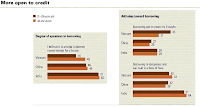This small but lively banking market encompasses the region’s largest generation gap in attitudes toward banking.
Nigel P. Andrade, Jens Lottner, and Christian Roland
Young adults, 21 to 29 years old, will play a large role in shaping Vietnam’s small but growing retail-banking market. These young consumers are less wary of borrowing, likelier to use remote channels, and more open to foreign banks than are their elders. And on most banking-related issues, the generation gap in preferences and attitudes is larger in Vietnam than in the 11 other Asian markets we examined as part of a study involving about 13,000 urban banking consumers across the continent.
Despite strong growth in recent years, retail banking in Vietnam remains small. Banking assets, for example, amounted to about $75 billion (some 123 percent of
To clarify the factors that might shape Vietnam’s nascent financial sector, we surveyed about 400 of the country’s banking consumers as part of our 2007 Asian personal-financial-services study. The pool represents urban households with annual incomes of more than 57 million dong, or about $3,500—almost 70 percent of the population of the cities.
Already, Vietnamese banking consumers 21 to 29 years of age hold, on average, more products than their elders do: 2.3 per respondent, compared with 1.9. Ninety-one percent of the young adults had savings accounts, compared with 55 percent of the respondents 30 years or older. Eighty-nine percent owned debit cards, compared with an average of 40 percent among the rest of our survey pool. In addition, young adults were much more willing than their elders to use remote-banking channels, such as telephones or the Internet (Exhibit 1), if banks could address their security concerns. In fact, the gap between young adults and the rest was much greater in Vietnam than in other Asian countries we surveyed. When we asked Vietnamese consumers whether they would use Internet banking in the future, for example, a 34-point gap separated young adults from those over 30, compared with 6 and 8 points in China and India, respectively.

Young adults were also more inclined to take out loans: 45 percent agreed that borrowing could improve their lifestyle, compared with 31 percent of the older adults. These young customers were also less likely than their elders to see borrowing as dangerous or unwise. On questions about loans, the generation gap was again much more pronounced in Vietnam than in the other countries in our study, including China and India (Exhibit 2).

State-owned banks hold more than two-thirds of Vietnam’s banking assets, deposits, and loans. But local private-sector banks, such as Asia Commercial Bank and Sacombank, have made inroads into this heavily contested sector and could gain further by tapping into the youthful enthusiasm we tracked. In addition, under Vietnam’s World Trade Organization commitments, the country agreed to open its banking sector to foreign banks in 2007. Foreign retail banks, though they still face obstacles, could benefit from latent demand once some of the restrictions facing them today—for instance, on the expansion of their branch networks—are eased.
Sixty percent of our respondents said that the entry of foreign banks into the country will be beneficial for them, with young adults (73 percent) particularly amenable to the idea. This finding reveals a greater openness to foreign banks than we saw in the other countries, where the percentage of those who felt that foreign banks would benefit them ranged from 22 percent (Taiwan) to about 54 percent (the Philippines). In a separate question, most Vietnamese banking consumers also said that dealing with local institutions remained important. The two results indicate that the Vietnamese are willing to consider any bank, local or foreign, that offers them the best deal for a particular product or service.

The Vietnamese survey also revealed clear regional differences, with respondents in Ho Chi Minh City expressing more open-minded attitudes than their compatriots in the north (Exhibit 3). Forty-two percent of our respondents in Ho Chi Minh City said they would try mobile banking, for example, compared with 24 percent in Hanoi. Only 39 percent in the south said it was unwise to borrow for anything except a house, compared with 46 percent in the north.
About the Authors
Nigel Andrade is an associate principal in McKinsey’s Singapore office, where Jens Lottner is a principal and Christian Roland is a consultant.
Notes
1The other markets in the 2007 study were China, Hong Kong, India, Indonesia, Japan, Malaysia, the Philippines, Singapore, South Korea, Taiwan, and Thailand. This was our sixth Asian personal-financial-services study since 1998 and the first to include Vietnam.

